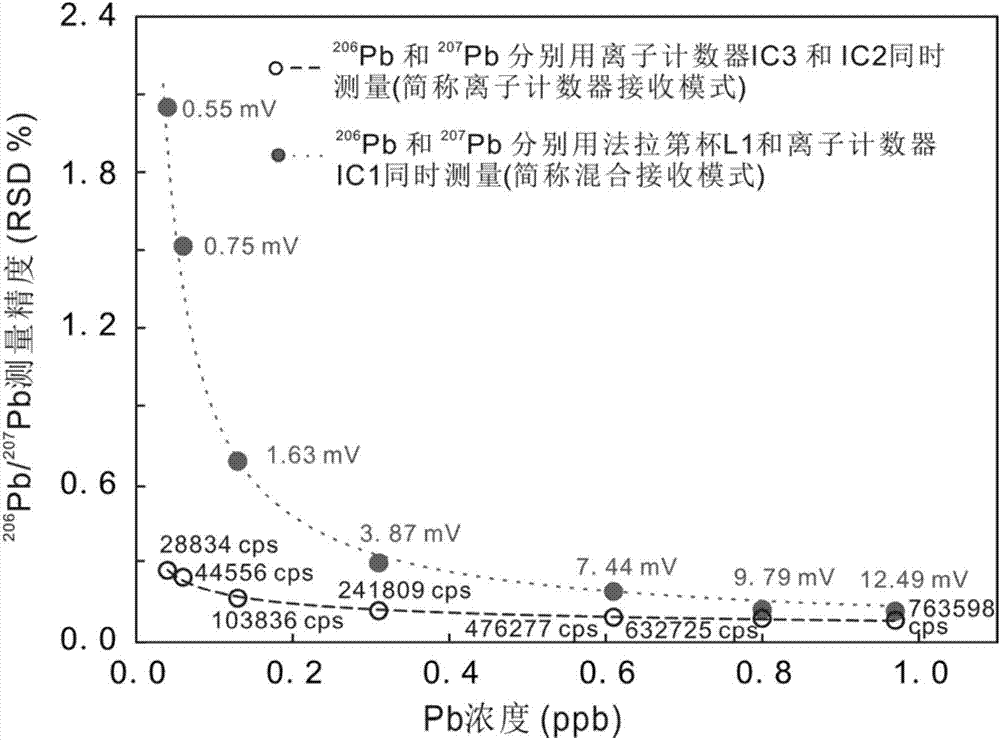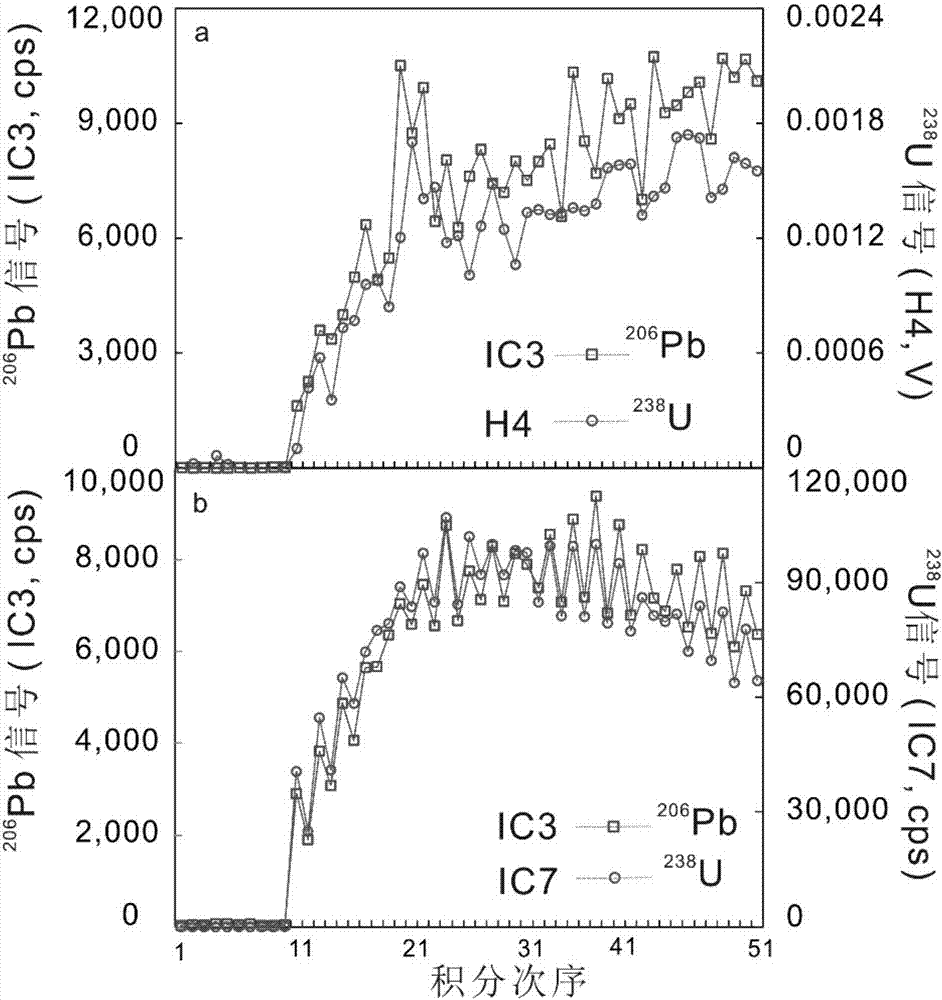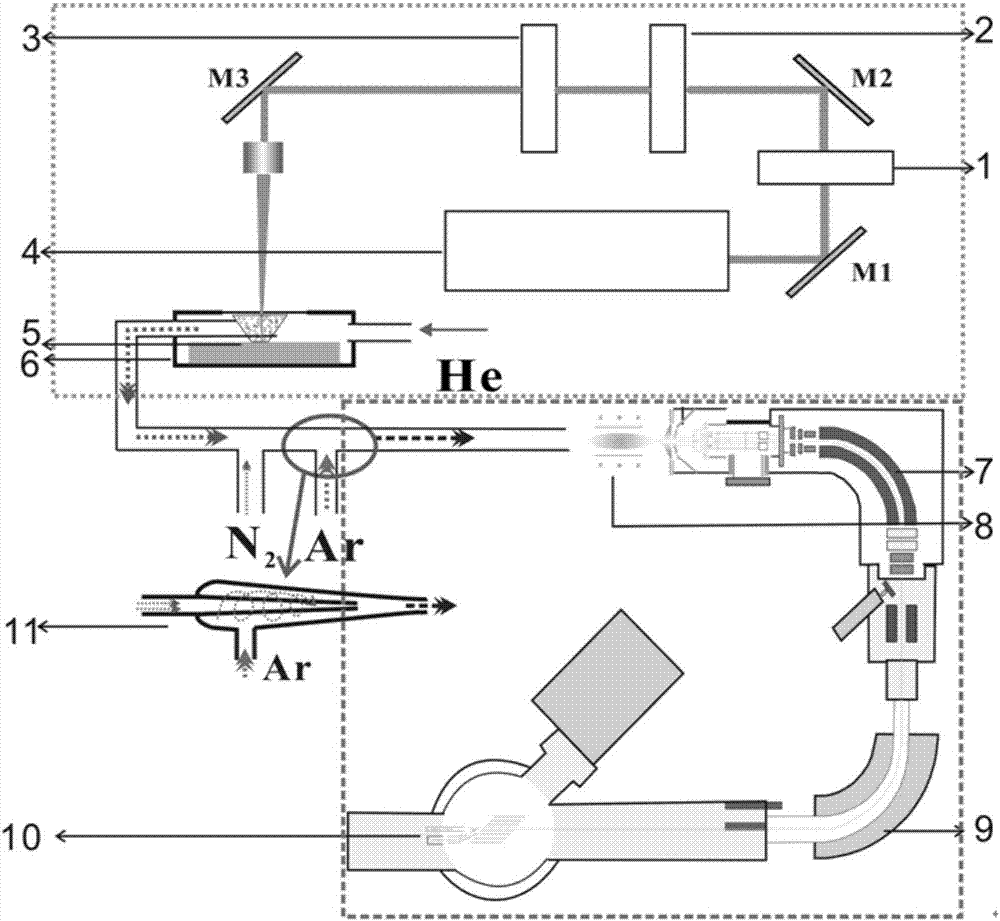Method for determining U-Pb age of zircon sample
A zircon and sample technology, applied in the field of micro-area isotope composition analysis, can solve the problems of increased denudation depth, low abundance sensitivity, and poor lateral spatial resolution
- Summary
- Abstract
- Description
- Claims
- Application Information
AI Technical Summary
Problems solved by technology
Method used
Image
Examples
Embodiment 1
[0054] Example 1 Comparative experiment on the ability of ion counters and Faraday cups to measure small signals (the instrument used in this experiment is Neptune Plus MC-ICP-MS, manufacturer: Thermo Fisher Scientific, Germany)
[0055] In this experiment, the conditions of laser ablation zircon shown in Table 1 were used to contain different concentrations of zircon (see figure 1 ) lead solution for experiment, first use ion counter IC3 and IC2 to measure simultaneously 206 Pb and 207 See figure 1 , indicated by open circles, measured at IC3 206 The intensity of the Pb ion current is marked next to the circle, and the unit is cps; then it is measured simultaneously by Faraday cup L1 and ion counter IC1 respectively 206 Pb and 207 Pb (mixed reception mode), measurement results see figure 1 , represented by a solid circle, measured at L1 206Pb ion current intensity is marked next to the circle in mV. The experimental results prove that when measuring small signals (less...
Embodiment 2
[0056] Example 2 Comparative experiment of multi-ion counter receiving mode and ion counter-Faraday cup mixed receiving mode
[0057] In this experiment, under the same laser ablation zircon conditions as in Example 1, the ion counter IC3 and the Faraday cup L4 were used to simultaneously receive 206 Pb and 238 U ion current, the resulting signal changes in figure 2 shown in a. It can be seen from this figure that the Faraday cup L4 measured 238 When the U signal reaches its peak value, it lags behind that measured by the ion counter IC3. 206 Pb signal, this hysteresis effect makes the measured 206 Pb and 238 The variation of U isotope ratio increases, which seriously affects the accuracy of U-Pb dating results. Then use ion counters IC3 and IC7 to receive simultaneously 206 Pb and 238 U ion current, the resulting signal changes in figure 2 b shows that it can be seen from the figure that the measured 206 Pb and 238 U signal changes are fully synchronized, meaning...
Embodiment 3
[0059] Based on the results of the above experiments 1 and 2, the following technical solutions are designed to solve the main problems in the current laser ablation in situ micro-area U-Pb dating technology.
[0060] Sample preparation: In this experiment, seven standard zircons were used: Phalaborwa, 91500, GJ-1, Temora, Plěsovice, Qinghu and SK10-2. These 7 zircon particles were embedded in a 2.54 cm (1 inch) epoxy resin sample target. The unknown sample was placed in the same or another epoxy resin sample target. After polishing, a cathodoluminescence image was taken with a scanning electron microscope to identify Core, mantle and edge structure relationships of zircon mineral grains.
[0061] Instrument composition: Mass spectrometer used for determination: Neptune Plus multi-receiver inductively coupled plasma mass spectrometer (Neptune Plus MC-ICP-MS, manufacturer: Thermo Fisher Scientific, Germany), equipped with 7 ion counters IC4, IC5, IC3A, IC2, IC1B1, IC6 and IC7,...
PUM
| Property | Measurement | Unit |
|---|---|---|
| size | aaaaa | aaaaa |
| depth | aaaaa | aaaaa |
| diameter | aaaaa | aaaaa |
Abstract
Description
Claims
Application Information
 Login to View More
Login to View More - R&D
- Intellectual Property
- Life Sciences
- Materials
- Tech Scout
- Unparalleled Data Quality
- Higher Quality Content
- 60% Fewer Hallucinations
Browse by: Latest US Patents, China's latest patents, Technical Efficacy Thesaurus, Application Domain, Technology Topic, Popular Technical Reports.
© 2025 PatSnap. All rights reserved.Legal|Privacy policy|Modern Slavery Act Transparency Statement|Sitemap|About US| Contact US: help@patsnap.com



